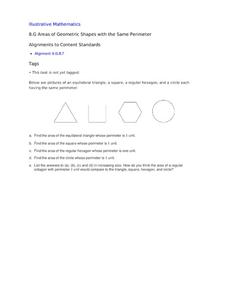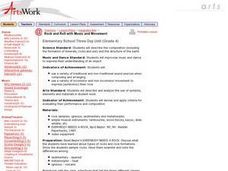Curated OER
Reintroduce an Irregular Word
Some words are tricky. Can your scholars quickly recognize irregularly spelled words? Write the word was on the board (or any irregular word you'd like to practice), touching each letter as scholars segment the phonemes. Explain that the...
Curated OER
Exploring Arrangements of 2, 3, 4, and 5 Cubes
Learners use problem solving skills to create various models of tricubes, tetracubes, and pentacubes. They classify the cubes into various groupings and identify them as mirror images, regular arrangements, and irregular arrangements....
Curated OER
Introduce an Irregular Word
Students study language. In this fluency lesson, students discover how to say a variety of irregular words (e.g. was). They work as a class or in a small group with the teacher as he or she introduces the words on the board or an index...
Curated OER
Reintroduce an Irregular Word
Students explore language arts by participating in a pronunciation activity. For this irregular word lesson, students must identify irregular words used in class and pronounce them when their teacher refers to one in class. Students...
Curated OER
Using Irregular Verbs - Exercise 1
In this irregular verbs worksheet, students complete twenty sentences that help them learn to identify and use irregular verbs.
Curated OER
Perimeter All Around
Learners explore perimeter and area of regular and irregular polygons. They experiment with color squares and create different arrangements using the same number squares. Then they compare the area and perimeter measurements of each.
American Chemical Society
Finding Volume: The Water Displacement Method
We have formulas for finding the volume of geometric shapes, but what if the shape is irregular? Lesson describes how to find volume through water displacement. After a demonstration, scholars practice in small groups. Then analysis...
Curated OER
Areas of Geometric Shapes with the Same Perimeter
A triangle, square, hexagon, and circle all have a perimeter of one unit. Eighth graders must attempt to find the area of each and arrange them in order from least to greatest areas. A terrific task for applying four different area...
Curated OER
Reintroduce /au/
Practice decoding au words with your first and second graders. They state the sound of au when the teacher points to the corresponding letter combination, and remain silent when any other letter combination is displayed. Complete this...
Illustrative Mathematics
Regular Tessellations of the Plane
Bringing together the young artists and the young organizers in your class, this lesson takes that popular topic of tessellations and gives it algebraic roots. After covering a few basic properties and definitions, learners attack the...
Curated OER
How Many Trees Can You Grow?
Students solve a story problem about how many trees can be planted in a given area. Using a map, they gather information about the size of the area and the dimensions of an acre. They use a specific equation to determine the area of...
Achievement Strategies
ACT College Readiness Standards
Here is a template offering a comprehensive outline of ACT skill categories, what standards are expected to be mastered, and blank spaces for you to include how you plan to address those standards within your curriculum.
Curated OER
Stick-Slip Movement
Ninth graders operate a model to observe the type of motion that occurs at a fault during an earthquake. They explore the effects of several variables. Students measure movement, calculate averages and plot and graph information.
Curated OER
Patterns & Balance
Learners compare and contrast the difference in the two sets of images and discuss the visual interest in the first set and the different visual interest created in the second set of prints.
Curated OER
Poetry In Motion
Fourth graders read and analyze poetry and examine the process of writing poetry. They read and analyze the poem "From a Railway Carriage" by Robert Louis Stevenson, and answer comprehension questions. They identify the similes,...
Curated OER
Could the Solar System have Ten Planets?
Students react to statements about the solar system, then read a news article about a recently discovered object that could be another planet. In this space science and current events lesson, the teacher introduces the lesson with a...
Curated OER
Paws in Jobland: Aspects of Working Life
Students discover concepts related to working conditions and practices. In this career lesson plan, students research information pertaining to specific jobs and then present it to their peers.
Curated OER
Mollusks
In this mollusks worksheet, students color several figures and label them with the correct parts. They complete 14 short answer questions related to mollusks.
Curated OER
Rock and Roll with Music and Movement
Fourth graders improvise music and dance to express their analysis of types of rocks. They discuss the three classes of rocks, list describing words, and create a short musical piece and dance to symbolize the rock they are dancing.
Curated OER
Geometry Geopardy
Third graders participate in a game in order to review geometric concepts.
Curated OER
Mapping Seamounts in the Gulf of Alaska
Students describe major topographic features on the Patton Seamount, and interpret two-dimensional topographic data. They create three-dimensional models of landforms from two-dimensional topographic data.






















